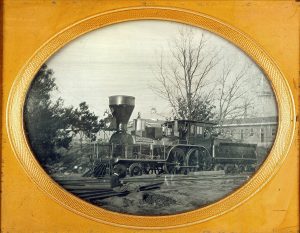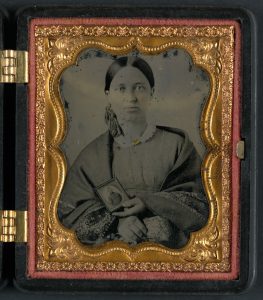Railroads: Women Refugees and the Railroads

Over the course of the Civil War, thousands of civilians left their homes and became refugees seeking safety. Several thoughts and questions quickly went into the minds of those put into unimaginable situations that turned their lives upside down. Where were they going to go? How were they going to get there? Was it safe? Whether trying to get to a specific destination or just get away from danger, refugees oftentimes used any type of transportation or resources they could, including the railroad.
Traveling by railroad had its advantages; it could accommodate much more than private carts or public stage coaches, it was faster, and it could be safer as well. As a result, it was the preferred method of transportation for those who could acquire it. However, getting a spot on a railroad car was difficult, especially in urban areas. Throughout the war, as the enemy soldiers approached a major metropolitan area, it sparked a hurried frenzy for civilians to get out of town or seek shelter if they could. One such evacuation took place in Jackson, Mississippi in 1864 when:
…the station was courted with crushing and elbowing human beings, swaying to and fro—baggage being thrown hither and tither. Those trying to get out of town were seeking the Mobile cars—seeking the Vicksburg cars—seeking anything to bear them away from the threatened and fast depopulating town.
Men, women, and children tried every which way they could to get their families and baggage if at all possible onto the railroads. A similar scene took place in Columbia, South Carolina when people were trying any possible means to get onto a railroad car, including hanging onto the sides of the cars and and climbing through the windows. One such woman tried to enter the train car by crawling through the window and “got caught halfway in and the train left while she dangled from the window. After much pulling, she was ‘hauled in by main force”. Another train was so crowded that “the people who could not get inside were hanging on wherever they could find a sticking place; the aisles and platform down to the last step were full of people clinging…like bees swarming around the hive”.

However, a lot of civilians using the railroad were members of the upper classes. They were “wealthier individuals who had chosen to abandon their customary place of residence, frequently with an eye to keeping property, especially enslaved property, out of Union hands”. They had the financial resources available to purchase tickets on private railroad lines—which were becoming increasingly expensive over the course of the war. They also had the ability to pack their belongings, by either trying to conceal it on the property, by packing it away on wagons pulled by animals—much more difficult to acquire towards the end of the war, or bringing it with them on the railroads. One such woman trying to get to Montgomery, Alabama was trying to get “rail accommodations for herself and ten heavy pieces of luggage” and another pair of sisters who were able to make it from Orange, Virginia to their aunt’s home in Gordonsville, where they were each given a room, but they “complained that they were too crowded for comfort because their trunks filled both rooms”. For many refugees who were able to pack baggage, it actually turned out to be more of a hindrance than an asset for it was much harder to obtain transportation. However, having the ability to prepare for weeks to become a refugee was a rare occurrence. Typically families only had days, if not hours, to gather what they could or leave only with what they could carry. For many of these families their options were either the animals and carriages they had available, or their own feet.
The topic of refugees during the Civil War requires much more space than a short blog post to delve into the complex and tragic history of what women, children, and families throughout the South were forced to endure in four years of war. From enslaved African Americans fleeing to contraband camps to escape slavery to families used to comfortable living forced into caves like during the Siege of Vicksburg or ad hoc camps, one thing is certain: these people were forced into unimaginable situations that many of us cannot even begin to comprehend.
Sources:
Faust, Drew Gilpan. Mothers of Invention: Women of the Slaveholding South in the American Civil War. Chapel Hill: University of North Carolina Press, 2000
Massey, Mary Elizabeth. Refugee Life in the Confederacy. Baton Rouge: Louisiana State University Press, 1964.

What became of all the women textile workers that Sherman shipped from their homes and families in TN or AL to Ohio?
On 25 April 1862 a late addition was included to page 3 of the “American Citizen” (newspaper of Canton Mississippi) just before it went to print: “We learn by telegram that Fort Jackson is evacuated. All cars need to be sent to New Orleans, forthwith.”
Up until that date, most residents of Confederate New Orleans believed that the twin forts of Jackson and St. Philip, with a stout barrier chain running between them, as well as a dozen gunboats (some of them ironclad) would be sufficient to prevent Farragut and Porter from getting close to the Crescent City, 68 miles away. But, when word of the protracted struggle taking place on the Mississippi River to the south reached them in mid-April, some of the wealthier families made excuse to “make an excursion” out of New Orleans and boarded passenger steamers heading north up the Mississippi River, or took the New Orleans, Jackson & Great Northern R.R. “to visit friends in Mississippi.” The rest of the inhabitants believed they would have plenty of time to get out of harms way, should that situation arise, and so were mostly startled on Friday, April 25th to witness the arrival of a dozen heavily armed steamships, under command of Flag-Officer Farragut, at the waterfront of their beloved city.
There was no time for the “extra cars” from Jackson Mississippi to arrive; the civilian population of New Orleans was stuck, and would have to make the most of their new circumstances…